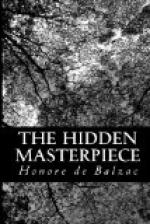“Yes,” continued the old man vehemently, “you draw a woman, but you do not see her. That is not the way to force an entrance into the arcana of Nature. Your hand reproduces, without an action of your mind, the model you copied under a master. You do not search out the secrets of form, nor follow its windings and evolutions with enough love and perseverance. Beauty is solemn and severe, and cannot be attained in that way; we must wait and watch its times and seasons, and clasp it firmly ere it yields to us. Form is a Proteus less easily captured, more skilful to double and escape, than the Proteus of fable; it is only at the cost of struggle that we compel it to come forth in its true aspects. You young men are content with the first glimpse you get of it; or, at any rate, with the second or the third. This is not the spirit of the great warriors of art,—invincible powers, not misled by will-o’-the-wisps, but advancing always until they force Nature to lie bare in her divine integrity. That was Raphael’s method,” said the old man, lifting his velvet cap in homage to the sovereign of art; “his superiority came from the inward essence which seems to break from the inner to the outer of his figures. Form with him was what it is with us,—a medium by which to communicate ideas, sensations, feelings; in short, the infinite poesy of being. Every figure is a world; a portrait, whose original stands forth like a sublime vision, colored with the rainbow tints of light, drawn by the monitions of an inward voice, laid bare by a divine finger which points to the past of its whole existence as the source of its given expression. You clothe your women with delicate skins and glorious draperies of hair, but where is the blood which begets the passion or the peace of their souls, and is the cause of what you call ‘effects’? Your saint is a dark woman; but this, my poor Porbus, belongs to a fair one. Your figures are pale, colored phantoms, which you present to our eyes; and you call that painting! art! Because you make something which looks more like a woman than a house, you think you have touched the goal; proud of not being obliged to write “currus venustus” or “pulcher homo” on the frame of your picture, you think yourselves majestic artists like our great forefathers. Ha, ha! you have not got there yet, my little men; you will use




